The Beggars’ Opera
The Beggars’ Opera Playing Cards were first published in 1728. The cards carry the words and music of the songs from Gay’s opera, which was intended as a parody of current Italian works. The music was taken from many popular tunes of the day.

The Beggars’ Opera Playing Cards, 1728
The Beggars’ Opera Playing Cards were first published in 1728. The cards carry the lyrics and music of the songs from John Gay’s opera, which was intended as a parody of current Italian works. The music was taken from many popular tunes of the day, mostly English and Scottish, even some French, and chosen and arranged by John Christopher Pepusch, a German who had settled in England and who was a composer as well as an adapter of stage musical works. The cards were engraved and printed from copper plates, with the red suit symbols being applied later by stencil. The court cards contain interesting miniature versions of the standard full-length figures used on playing cards at the time.
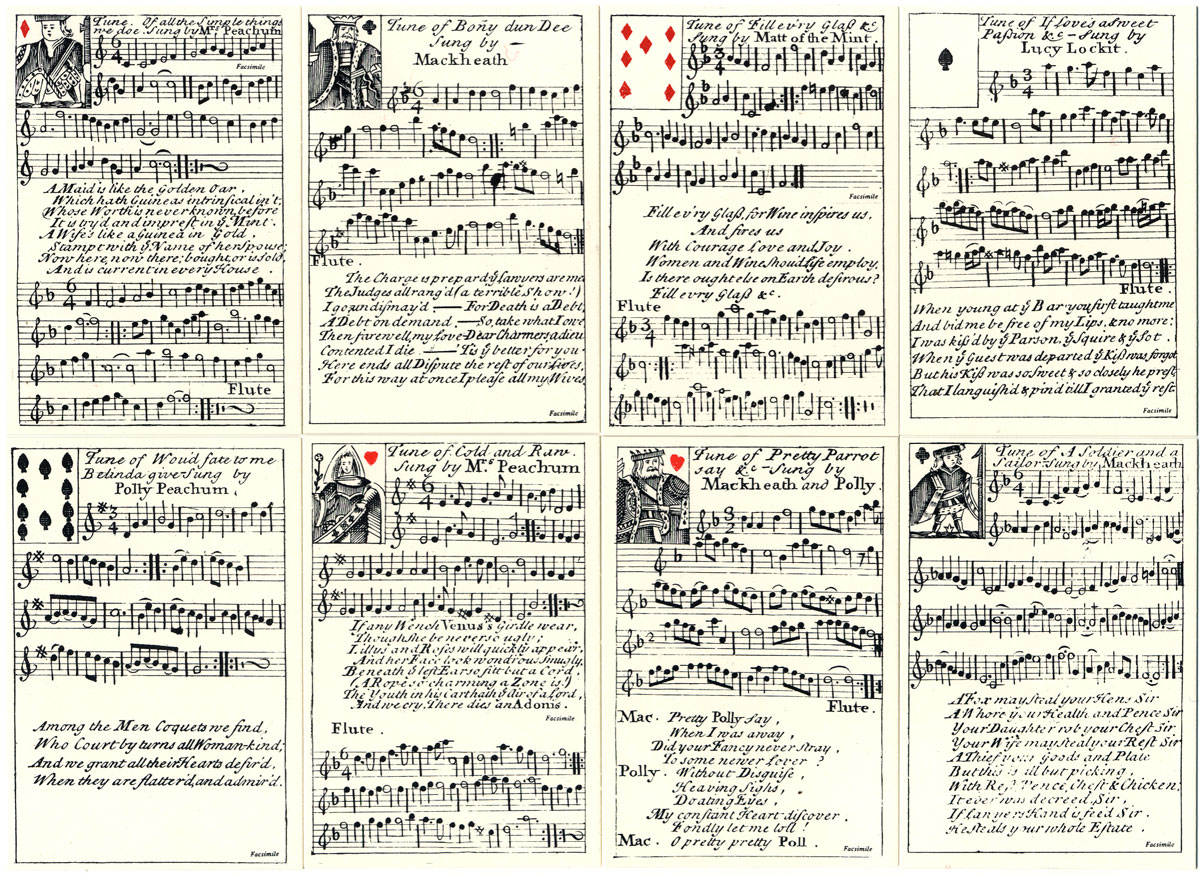
Above: the Beggars’ Opera pack of playing cards was first published in 1728, the year of the first production of the opera, by John Bowles, a member of the famous London family of mapmakers and printsellers. "The Beggar’s Opera" is so called because it opens with a dialogue between a ragged beggar, who claims to be the author, and one of the actors. The beggar does not return until the final scene, but meantime the stage is taken over by the more familiar, even notorious characters, whose names are still household words. A facsimile of the pack is part of a range published by Harry Margary. Cards from the facsimile edition courtesy Giles de Margary. Packs can be ordered directly from www.harrymargary.com
Nine of Clubs: A Nine of Clubs was preserved at Strawberry Hill as a curious musical memento. The poet Gay had inscribed upon it a couplet from the Beggar’s Opera and given it, signed, to a lady as a souvenir.
By Simon Wintle
Spain • Member since February 01, 1996 • Contact
I am the founder of The World of Playing Cards (est. 1996), a website dedicated to the history, artistry and cultural significance of playing cards and tarot. Over the years I have researched various areas of the subject, acquired and traded collections and contributed as a committee member of the IPCS and graphics editor of The Playing-Card journal. Having lived in Chile, England, Wales, and now Spain, these experiences have shaped my work and passion for playing cards. Amongst my achievements is producing a limited-edition replica of a 17th-century English pack using woodblocks and stencils—a labour of love. Today, the World of Playing Cards is a global collaborative project, with my son Adam serving as the technical driving force behind its development. His innovative efforts have helped shape the site into the thriving hub it is today. You are warmly invited to become a contributor and share your enthusiasm.

Leave a Reply
Your Name
Just nowRelated Articles
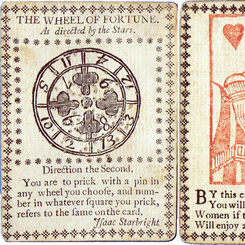
Fortune Telling playing cards
English Fortune Telling cards probably published c.1770.

Arms of English Peers
The Arms of English Peers playing cards were first published in 1686. Heraldry, or a knowledge of th...

Origins Playing Cards
Rick Davidson's “Origins” playing cards is an inspired, present-day re-design of the standard Anglo-...
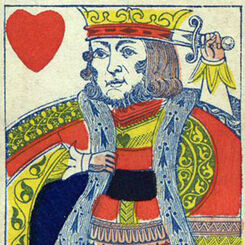
Suicide King
The King of Hearts, holding a sword behind his head, is sometimes nicknamed the “Suicide King”. He c...

William Warter
William Warter's Proverbial Cards, which carry illustrations of old English proverbs, were first pub...
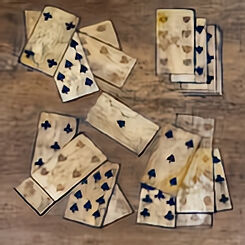
Eglantine Table
The Eglantine Table, Hardwick Hall, Derbyshire, elaborately inlaid with marquetry depicting musical ...
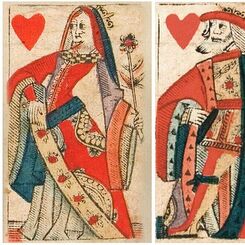
Pierre Marechal
Rouen became an important centre for card-making whose influence extended far afield. Cards from Rou...
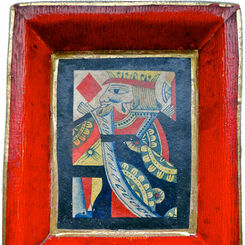
Pope Joan Trays
Some traditional Pope Joan boards comprise a circular tray, others are square, divided into sections...

Mathematical Instruments
Mathematical Instruments playing cards forming an instrument maker's trade catalogue, Thomas Tuttell...
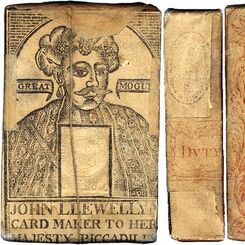
John Llewellyn, playing card manufacturer, London, 1778-1785
John Llewellyn, playing card manufacturer, London, 1778-1785

History of Court Cards
The court cards in English packs of playing cards derive from models produced by Pierre Marechal in ...

Hand-made Spanish Suited Playing Cards
Decks are made on two-ply pasteboard which reproduces the tactile quality of antique cards.

History of English Playing Cards & Games
The History of English Playing Cards dates probably from the mid 15th century

South Sea Bubble
The South Sea Bubble Playing Cards were first published in London by Thomas Bowles in 1720. The card...
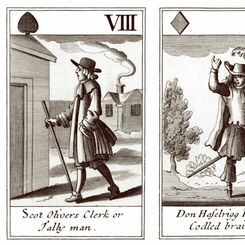
Knavery of the Rump, 1679
The Knavery of the Rump playing cards, first published in 1679, are a satirical portrayal of Oliver ...

Cries of London
The cards were printed from copper plates, with the red suit symbols being applied later by stencil....

Marlborough’s Victories
Marlborough’s Victories playing cards, first published in 1707, depict Marlborough's campaigns and t...

Hofamterspiel, c.1460
Hofamterspiel, c.1460

Hewson Replica Pack
Hand-made replica 17th century English playing cards, based on museum originals.

Woodblock and Stencil Playing Cards
Around 1987 I decided to make a pack of playing cards from woodblocks and coloured with stencils. I ...
Most Popular
Our top articles from the past 60 days


 Your comment here. Your comment here. Your comment here. Your comment here. Your comment here. Your comment here. Your comment here. Your comment here. Your comment here. Your comment here. Your comment here. Your comment here. Your comment here. Your comment here. Your comment here. Your comment here. Your comment here. Your comment here. Your comment here. Your comment here. Your comment here. Your comment here. Your comment here. Your comment here. Your comment here. Your comment here. Your comment here. Your comment here. Your comment here. Your comment here. Your comment here. Your comment here.
Your comment here. Your comment here. Your comment here. Your comment here. Your comment here. Your comment here. Your comment here. Your comment here. Your comment here. Your comment here. Your comment here. Your comment here. Your comment here. Your comment here. Your comment here. Your comment here. Your comment here. Your comment here. Your comment here. Your comment here. Your comment here. Your comment here. Your comment here. Your comment here. Your comment here. Your comment here. Your comment here. Your comment here. Your comment here. Your comment here. Your comment here. Your comment here.




















